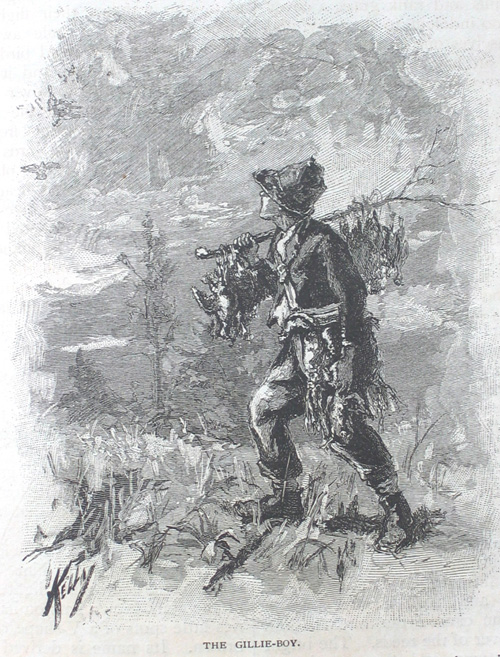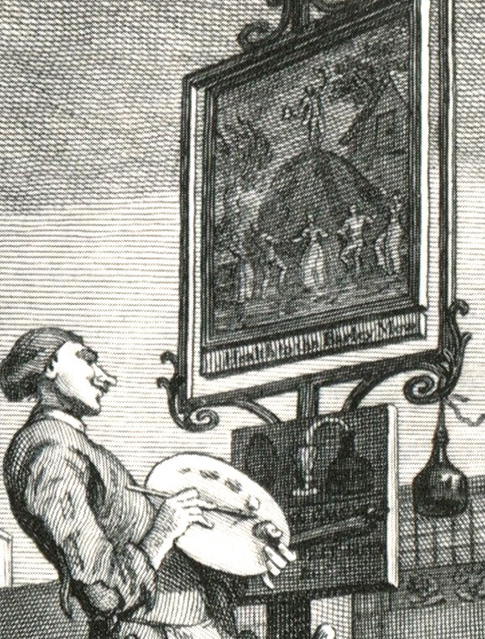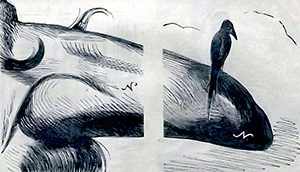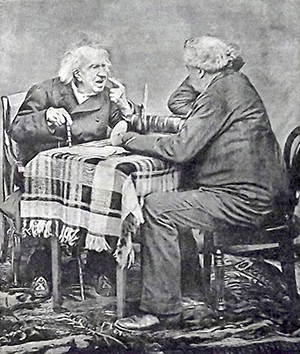Alexander Roob]
[November 19, 2011
William James Linton – A Life in the Collections
On the Formations of Political Art and Wood Engraving
William James Linton has left behind an immense body of artistic work. He executed thousands of commissioned and autonomously conceived engravings, a number of paintings and watercolours; moreover, he served as editor to several journals, ran his own private presses, contributed hundreds of poems and polemics to various newspapers, published five volumes of poetry, one autobiography, four biographies, two histories of wood engraving, several children’s books, five anthologies of British and foreign poetry, and on top of all this, he also translated numbrous poems and tracts from the French, Italian and Polish. The authors of his obituaries agreed: he was the busiest man they had ever met.
The reception of this work has to be extremely unclear, since his endeavors had veered off in many different directions which probably only for him happily coexisted, each of which would write forth its own separate bibliography, their subjects often not knowing of each other. For reasons of clarity, it would make sense to distinguish several different Lintons: There is one Linton in the history of private presses, another Linton in the history of Victorian poetry, and yet another in the history of working class culture; then we have a Linton in the more specific scholarly field of research on Romanticism, and a Linton in the history of typography and the graphic arts; and then, we also frequently meet the concept of the Lintonesque in the work of a noted historian of photography. It is to be assumed that such a multifaceted artist who managed to create such rich resonances should be a prominent figure; yet, the opposite is the case. As the sum total of all his specifications, we have a personality who is a dark horse to art historians, still left “at the edge of what is remembered of the nineteenth-century world” where his biographer, the social historian Francis Barrymore Smith had sought to pick him up in the early 1970s, irrecognizably in his multiple relations to the Romantic tradition, the early Barbizon realism, and the Aesthetic movement, blurred between high mass of Blake references and the artistic low tide of Victorian xylographic mass production.
Late Linton at his private Appledore press in Hamden / CT
The most suitable term to characterise his shifting position and his transitory activities might be „agency.“ Agency – this was the nature of his basic activities as xylographic interpreter and of his occupations as a literary translator, anthologist, polemicist, and teacher. Politically, he was the agent of the Chartist movement during the proceedings of the Second Republic in Paris, of the Italian unification in London and New York, and of Edmund Davis´s socialist Utopia in Montana. Culturally, he acted as the early agent of French Christian Socialism in England and as the late agent of British radicalism in America. Artistically, he was the premature agent of Art Noveau and of modern purist book design in Historicist times, and a promoter of graphic expressionism in the times of rising Impressionism. Nothing might be more suited to express the prejudice of hieratic high-brow culture against such a catalytic and society-oriented understanding of art such as Thomas Carlyle’s verdict: He spoke of Linton’s extreme „windiness“. And in fact one might say that it was a kind of windiness that left its progressive marks on numerous interdisciplinary joints and that had implemented in the artistic climate of Utilitarianism, a relatively open societal notion of art and authorship.
“There is, unfortunately, no complete bibliography of Linton’s artistic productions – nor, I suppose, is one really possible, given his enormously varied jobs and enterprises that included hundreds of unsigned as well as signed engravings.“ This frustrated diagnosis of the state of reception of Linton´s work that Robert Gleckner, a scholar of British Romanticism, made in 1982 still applies today. The problem lies but less in the variety and amount of commissioned and autonomous engraver’s works, but rather in the question what we could conceive of and subsume as his artistic production. There can be little doubt that Linton was the most committed Republican artist of his century, as he was widely renowned for having centered all his efforts, whether as activist or as theorist, around The Cause. The early working class movement had its poets and writers, and it was indeed backed by some professional caricaturists; it even had its sympathizers within academic artistic circles. But as a Chartist artist immediately involved in The Cause, Linton held a solitary position. To follow the various strands of his production means to witness the gradual experimental formation of an „interventionist“ type of art – to use a contemporary expression. In many respects he can be called the first political artist sui generis.
Masthead of Julian Harney´s “The Red Republican” (1850-51), designed and engraved by iLinton
W.J. Linton: Famine. A Masque. Hamden / CT 1875 (after pl. 9 of W. Blake´s illuminated prophecy “Europe” )
“The Capitalist Vampire” (1885) by Linton´s collaborator and disciple Walter Crane (in: Cartoons for the Cause. Designs and verses for the Socialist and Labour Movement. London 1896)
His views were decisively shaped by the respective role models and teachings of William Johnson Fox and Giuseppe Mazzini. The former, a highly influential editor, writer and orator, and spiritus rector of the first British avant-garde movement, stood representative for a fundamental democratisation of culture that also strove to include an authentic working class perspective; the latter, figurehead of the international Republican liberation movement, had vehemently appealed for culture as a means of emancipatory propaganda. Linton most consequentially had followed Mazzini’s conception, according to which an art conscious of its political responsibility should be able to reconcile and unite theory and practice / agency. Following the Byronic scheme of the confluence of life, art and political committment, Mazzini had specified the duties of an artist as being „priest of universal life and prophet of high social aim.“ Departing from this perspective of an expanded conception of art, of a politico-artistic Gesamtkunstwerk, it is most appropriate to grasp Linton’s whole body of writings as well as his numerous activities in the name of the Chartists and the International League as legitimate parts of his artistic production.
Andrew Ashton: Portrait of William Johnson Fox (after a Crayon Sketch)
Wood engraved Portrait of Giuseppe Mazzini (from Linton´s proof print collection)
Under the conditions of the advanced industrialisation of the mid-19th century such a claim for totality could not be condensed anymore into any coherent form of archaic holism, such as it had been the case with Blake´s body of illuminated poetry. Linton could only justly decry the nostalgic attempts of the Pre-Raphaelites and the Morris Press as a vain and ridiculous purism. His polemics against the graphic mode of facsimile cut, which had been propagated by both groups, were pinpoint targeted against an ideology of authenticity that could just barely mask its feudal base of slavish dependency. The opposition between the communitarian varieties of Linton’s idea of radical democracy and the elitist Tory socialism of the likes of Carlyle and Ruskin that became socially acceptable by the educated middle class after the Chartists’ failure of 1848, was a smouldering one, never really outspoken. The latter party succeeded in political as well as in aesthetical respects: Facsimile became the basic signature of the 20th century, the power structure of absolutism hidden under a veil of universal brotherhood and modernist claims of authenticity.
Much more complicated from today’s point of view is Linton’s opposition to his American disciples, who organised themselves as The New School of xylography. Their versatile photographic hyperrealism was substantially inspired by Linton’s anti-authoritian role model of the artist-artisan as a creative translator, but he mistook their forward-looking efforts to create an egalitarian kind of surface aesthetics for an authoritarian syntax of industrial dehumanization.
W.J. Linton, reproduction print (detail), The Illustrated London News, 1846
Timothy Cole: The Gillie- Boy, from the revolutionary series of engravings after gouaches by J.E. Kelly, in: Scribner´s Monthly Magazine 1877
Timothy Cole: The Gillie-Boy (detail ) Scribner´s Monthly Magazine 1877
Political art, as moulded by Linton, can be structurally defined as an open free-style space which is confined by two limits of dependency and mechanic reproduction: linearism (Linearity) as an expression of ancient feudalism on the one side and pointillism as a visual manifestation of modern capitalism on the other side; here the slavery of the facsimile, there the terror of the halftone. If there ever was something like a characteristic style, a Lintonesque style, it could only mean a lively and rather unpredictable mixture of distinctive blackline engraving with stippled and scratchy parts representing blurriness. It had not been pure coincidence that the discipline of modern communication theory with William M. Ivins’s fundamental work Prints and Visual Communication as a starting point was inflamed by Ivin´s dealing with a widely recognized discussion about graphic structures that was held between Linton and the New School in the American press in the early 80s. Linton’s life reflects all development steps of wood engraving, that dominant technique of reproduction graphics, from its rather crude beginnings to its final agony in a stage of utmost refinement. And moreover, due to his versality, his biography bears the potential to shed light on the diverse cultural milieus that where involved in this progress of xylography.
In 1866 Linton had emigrated to North America, and this biographic crossroads points to a further problem any comprehensive review of Linton’s work inevitably has to deal with. An oeuvre that is extremely sensitive to the particular socio-political conditions and to topical affairs gets splitted into the contrasting circumstances of three epochs and two continents: England in the situation of the early domestic working class movement and that of the post-1848 decade, which was characterized by an increased awareness for foreign affairs, and the conditions of North America in the epoch of the so-called Gilded Age, where Linton attended with his biting polemics the establishment of a political system that claimed to be a democracy but bluntly turned out to be a plutocracy.
W.J. Linton: The House That Tweed Built. Cambridge/Mass. 1871
This commented bibliography of the Linton Archive is divided into four parts, according to the major chapters of his biography. Without laying claim to meet Gleckner’s request for completeness, it rather represents an attempt to give an effective impression of the richness and intrinsic complexity of an artistic work, which perhaps more than any other reflects the central conflicts of its age and encompasses through its didactic efforts and its impelling ideal of a democratisation of arts both levels of culture, „high“ and „low“. One might have to search long to find any other 19th century artist whose work is of comparable topicality and relevance today.
The multi-perspectivity and open structure of a bibliography may be the most suitable form to tackle the bewildering variety of Linton’s approaches without constricting them by over-generalizing assumptions. It is up to the reader to make his or her way through a maze of interdependencies between radical politics, early illustrated press, fragmented print culture, high-brow Pre-Raphaelism, republican historiographies, conceptions of illustration as cooperation, as well as various kinds of poetry and visions of direct democray.
Listed are not exclusively his own works but also those in which he participated, and also a small selection of those who had a substantial impact on him – and some he influenced. The final section is dedicated to the history of his reception, from the date of his death onwards. The issues are predominantly listed in the chronological order of the first edition’s publication dates, but there are some exceptions where they can follow a more biographical logic. The comments represent a multitude of voices. Besides my own comments, one can find repeatedly excerpts from Linton’s breathless shorthand style autobiography, from Francis Barrymore Smith’s biography whose dense maze of information is less concerned with Linton’s artistic production than with his Chartist network, and from works by numerous scholars from various disciplines. They are listed at the end.
The availability of relatively cheap new printing technology had provided the British Radicals in the beginning of the 19th century with better means to communicate with their expanding circles of birds of a feather. Linton with his numerous auteur-journals and private partisan presses was one of the most prolific and enthusiastic exponents of this early prefiguration of today’s „bloggerism.“ So what could be a more genuine medium to publish him today than the universal res republic of the www?
Alexander Roob, December 2010
Linton – A Life in the collections can count as the probably most comprehensive monographic source related to the history of political art in the 19th century. She comprises more than 200 articles and commentaries illustrated with more than 1,000 pictures in the online version. In addition, pure text versions are available as PDFs.
W.J. Linton: The religion of Organization. Boston 1869
A List of Linton Collections:
The Linton Archive of the Melton Prior Institute, Düsseldorf, seeks to collect Linton’s work both in its political and artistic contexts throughout all periods. Beside this Archive, there are several other, more specialized collections of scholarly interest:
– The British Museum, London, holds the most complete record of Linton’s writings. In 1895, Linton presented an enormous body of scrapbooks, titled Prose and Verse written in the course of fifty years 1836 – 1886, to the Museum’s library. It consists of twenty volumes and includes almost every poem and article of the author’s long career. Also in terms of design, this series can be considered as an artwork in its own right.
– The Linton Collection of the Princeton University Manuscripts Division is the richest in terms of reproduction graphic matters. It consists mainly of the author’s correspondence with the art historian and curator Sylvester Rosa Koehler, in which he discusses different engraving techniques in detail.
– The Linton Archive of the National Library of Australia, Canberra is part of a large collection on British economy. The Linton section consists of ca. 300 letters of mainly domestic concern, 15 booklets, and 22 pamphlets.
– The Beinecke Rare Book & Manuscript Library at Yale University holds some materials from Linton’s Brantwood years, but mainly the correspondence and prints from his American period.
– The Istituto Giangiacomo Feltrinelli, Milan, predominantly holds the political correspondence of the 1840s and 1850s.














